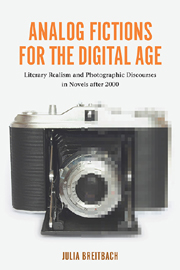 Analog Fictions for the Digital Age
Analog Fictions for the Digital Age Book contents
- Frontmatter
- Contents
- Acknowledgments
- Introduction: Toward a Photographic Reading of Literary Realism
- 1 Photography in the Digital Age: Critical Contexts and the Question of Realism
- 2 This Thing in the Text: Photography, Thing Theory, and the Return to Realism in Literature
- 3 Liminal Realism: Don DeLillo, The Body Artist (2001)
- 4 Domestic Realism: Ali Smith, The Accidental (2005)
- 5 Poetic Realism: Michael Ondaatje, Divisadero (2007)
- 6 Conclusion: The Way We Write Now—A Case for Realism(s)
- Works Cited
- Index
Introduction: Toward a Photographic Reading of Literary Realism
Published online by Cambridge University Press: 05 April 2013
- Frontmatter
- Contents
- Acknowledgments
- Introduction: Toward a Photographic Reading of Literary Realism
- 1 Photography in the Digital Age: Critical Contexts and the Question of Realism
- 2 This Thing in the Text: Photography, Thing Theory, and the Return to Realism in Literature
- 3 Liminal Realism: Don DeLillo, The Body Artist (2001)
- 4 Domestic Realism: Ali Smith, The Accidental (2005)
- 5 Poetic Realism: Michael Ondaatje, Divisadero (2007)
- 6 Conclusion: The Way We Write Now—A Case for Realism(s)
- Works Cited
- Index
Summary
Realist literature is attached to the visual, to looking at things, registering their presence in the world through sight.
—Peter Brooks, Realist VisionIn “The Real Thing,” Henry James's famous short story on the arts in the age of photography, a peculiar paragone takes place. Vying for the attention of the narrator-protagonist, a painter-cum-illustrator, and urging him to employ them as models are, on the one hand, Mr. and Mrs. Monarch, impoverished aristocrats who pride themselves on being “the real thing” yet miserably fail to inspire the artist's imagination. That they have successfully modeled for photographers (“We've been photographed—immensely,” James 2003b, 510) further disqualifies them, the narrator finds. The allegorical connection is clear: too real, too literal, and too perfect in keeping up appearances, the Monarchs are “like a photograph or a copy of a photograph,” “insurmountably stiff” and with “no variety of expression” (515).
On the other hand, pitted against the Monarchs’ dullness are the uneducated, hardly sophisticated lower-class characters, Ms. Churm and Oronte, whose extraordinary malleability, liveliness, and “talent for imitation” (516) make them “the ideal thing” (523) rather than “the real thing.” Paradoxically, they inspire a more authentic art than does the latter: “I liked things that appeared,” the narrator reflects, “then one was sure.
- Type
- Chapter
- Information
- Analog Fictions for the Digital AgeLiterary Realism and Photographic Discourses in Novels after 2000, pp. 1 - 28Publisher: Boydell & BrewerPrint publication year: 2012


